Picture |
Satellite
#NORAD |
Description |
Launch Date |
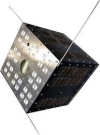
|
ShindaiSat
ShindaiSat-1
#39572
(2014-009A) |
ShindaiSat is a 20kg
satellite launched on February 27th
2014 at 18:37 UTC on the H-IIA launch vehicel #23 (H-IIA
F23) along with the GPM satellite. Its orbit is a 407km
circular orbit with an inclination of 65 degrees. ShindaiSat
transmits on 437.525 MHz a AX.25 1200bd AFSK signal.
In addition it features a CW beacon on 437.305 MHz.
It also will transmit and receive light signals. The
LED beacon signal will use Morse Code. ShindaiSat-1
is operational. |
Feb
27th 2014 |
 On May
3rd 2014 Davide IW0HLG received
the CW signal of ShindaiSat. Recording kindly provided
by Davide IW0HLG. On May
3rd 2014 Davide IW0HLG received
the CW signal of ShindaiSat. Recording kindly provided
by Davide IW0HLG.
|
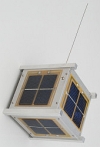
|
ITF-1 YUI
#39573
(2014-009B) |
ITF-1 is
a 1U cubesat built by students at the University of
Tsukuba. The designated callsign is JQ1ZLO. It was launched
on February 27th 2014 at 18:37
UTC on the H-IIA launch vehicel #23 (H-IIA F23) along
with the GPM satellite. Its orbit is a 407km circular
orbit with an inclination of 65 degrees. ITF-1 transmits
on 437.525 MHz a morse code signal in FM modulation.
Unfortunately the mission was unsuccessful:
no signals from the spacecraft were ever received. ITD-1
YUI re-entered the Earth's atmosphere on June 29th
2014. |
Feb 27th
2014 |

|
OPUSAT
#39575
(2014-009D) |
OPUSAT was launched on
February 27th 2014 at 18:37
UTC on the H-IIA launch vehicel #23 (H-IIA F23) along
with the GPM satellite. Its orbit is a 407km circular
orbit with an inclination of 65 degrees. OPUSAT transmits
on 437.150 MHz either a AX.25 1200bd AFSK or a AX-25
9600bd GMSK signal. OPUSAT is operational. |
Feb
27th 2014 |
 On April
19th 2014 Davide IW0HLG received
the CW signal of OPUSAT. Recording kindly provided by
Davide IW0HLG. On April
19th 2014 Davide IW0HLG received
the CW signal of OPUSAT. Recording kindly provided by
Davide IW0HLG.
|
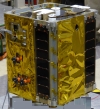 |
TeikyoSat-3
#39576
(2014-009E) |
TeikyoSat-3 was launched
on February 27th 2014 at 18:37
UTC on the H-IIA launch vehicel #23 (H-IIA F23) along
with the GPM satellite. Its orbit is a 407km circular
orbit with an inclination of 65 degrees. TeikyoSat-3
transmits on 437.450 MHz a AX.25 1200bd AFSK signal.
In addition it features a CW beacon on 437.450 MHz.
Teikyosat-3 is operational. |
Feb
27th 2014 |
 Mike
DK3WN received the CW signal of TeikoSat-3 on March
3rd 2014 at 16:20 UTC. Recording
kindly provided by Mike DK3WN. Mike
DK3WN received the CW signal of TeikoSat-3 on March
3rd 2014 at 16:20 UTC. Recording
kindly provided by Mike DK3WN.
|
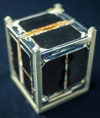
|
Cubesat
OSCAR-77
CO-77
ARTSAT INVADER
ARTSat-1 Invader
#39577
(2014-009F) |
ARTSAT INVADER was launched
on February 27th 2014 at 18:37
UTC on the H-IIA launch vehicel #23 (H-IIA F23) along
with the GPM satellite. The callsign of this Japanese
Cubesat is JQ1ZKK. Its orbit is a 407km circular orbit
with an inclination of 65 degrees. ARTSat-1 Invader
transmits on 437.200 MHz either a AX.25 1200bd AFSK
signal or operates as a FM digitalker. In addition it
features a CW beacon on 437.325 MHz. ARTSAT INVADER
was fully operational until it decayed on September
2nd 2014. |
Feb
27th 2014 |
 This recording
includes the CW beacon and at the end the first voice
message received from the digitalker of ARTSAT INVADER
on February 28th 2014. Recording
kindly provided by Akihiro Kubota-san on behalf of the
ARTSAT project team. This recording
includes the CW beacon and at the end the first voice
message received from the digitalker of ARTSAT INVADER
on February 28th 2014. Recording
kindly provided by Akihiro Kubota-san on behalf of the
ARTSAT project team.
|
 On March
29th 2014 the digitalker of
CO-77 transmitted a synthesized English voice message
"Stay Hungry". Recording kindly provided by
Akihiro Kubota-san on behalf of the ARTSAT project team. On March
29th 2014 the digitalker of
CO-77 transmitted a synthesized English voice message
"Stay Hungry". Recording kindly provided by
Akihiro Kubota-san on behalf of the ARTSAT project team.
|
 On May
21st 2014 the digitalker of
CO-77 transmitted a synthesized voice message meaning
in English "Love and Peace". Recording kindly
provided by Akihiro Kubota-san on behalf of the ARTSAT
project team. On May
21st 2014 the digitalker of
CO-77 transmitted a synthesized voice message meaning
in English "Love and Peace". Recording kindly
provided by Akihiro Kubota-san on behalf of the ARTSAT
project team.
|
 The digitalker
downlink of INVADER was received on May 22nd
2014 at 18:34 UTC by Mike DK3WN. The synthesized voice
message is "Kooichiha Uchu" (in English "Hello
Space". Recording kindly provided by Mike DK3WN. The digitalker
downlink of INVADER was received on May 22nd
2014 at 18:34 UTC by Mike DK3WN. The synthesized voice
message is "Kooichiha Uchu" (in English "Hello
Space". Recording kindly provided by Mike DK3WN.
|
  Also
Jan PE0SAT received the digitalker of INVADER at the
same time. Recording and spectrum plot kindly provided
by Jan PE0SAT. Also
Jan PE0SAT received the digitalker of INVADER at the
same time. Recording and spectrum plot kindly provided
by Jan PE0SAT.
|
 On August
25th 2014 the digitalker of
CO-77 transmitted a synthesized voice message meaning
in English "Goodbye Space". Recording kindly
provided by Akihiro Kubota-san on behalf of the ARTSAT
project team. On August
25th 2014 the digitalker of
CO-77 transmitted a synthesized voice message meaning
in English "Goodbye Space". Recording kindly
provided by Akihiro Kubota-san on behalf of the ARTSAT
project team.
|
 On August
27th 2014 the digitalker of
CO-77 transmitted a synthesized voice message meaning
in English "Forever Invader". Recording kindly
provided by Akihiro Kubota-san on behalf of the ARTSAT
project team. On August
27th 2014 the digitalker of
CO-77 transmitted a synthesized voice message meaning
in English "Forever Invader". Recording kindly
provided by Akihiro Kubota-san on behalf of the ARTSAT
project team.
|
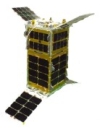
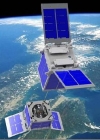
|
STARS-II
Mother
STARS-II M
STARS-2 M
JR5YDX
#39579
(2014-009H) |
STARS-II (Space Tethered
Autonomous Robotic Satellite-2) is a nanosatellite technology
demonstration project from Kagaa University in Japan.
It consists of a mother-daughter satellite configuration
communicating through Bluetooth. STARS-II (mother) was
launched on February 27th 2014
at 18:37 UTC on the H-IIA launch vehicel #23 (H-IIA
F23) along with the GPM satellite. Its orbit is a 407km
circular orbit with an inclination of 65 degrees. STARS-II
(mother) transmits on 437.405 MHz AX.25 1200bd AFSK
signal. In addition it features a CW beacon on 437.245
MHz. STARS-II M is operational. |
Feb
27th 2014 |
 Davide
IW0HLG received the CW signal of STARS-II Mother. Recording
kindly provided by Davide IW0HLG. Davide
IW0HLG received the CW signal of STARS-II Mother. Recording
kindly provided by Davide IW0HLG.
|
 Mike
DK3WN received the CW signal of STARS-II Mother on March
6th 2014 at 18:07 UTC. Recording
kindly provided by Mike DK3WN. Mike
DK3WN received the CW signal of STARS-II Mother on March
6th 2014 at 18:07 UTC. Recording
kindly provided by Mike DK3WN.
|


|
STARS-II
Daughter
STARS-II D
STARS-2 D
JR5YDY
#39579
(2014-009H) |
STARS-II (Space Tethered
Autonomous Robotic Satellite-2) is a nanosatellite technology
demonstration project from Kagaa University in Japan.
It consists of a mother-daughter satellite configuration
communicating through Bluetooth. STARS-II (daughter)
was launched on February 27th
2014 at 18:37 UTC on the H-IIA launch vehicel #23 (H-IIA
F23) along with the GPM satellite. Its orbit is a 407km
circular orbit with an inclination of 65 degrees. STARS-II
(daughter) transmits on 437.425 MHz a AX.25 1200bd AFSK
signal. In addition it features a CW beacon on 437.255
MHz. STARS-II D is operational.
I am searching for sound files. Please
send them to
 |
Feb 27th
2014 |
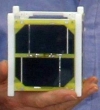
|
LitSAT-1
#39570
(1998-067EM) |
LitSAT-1
was development by Lithuanian Space Association. It
uses the callsign LY1LS. The IARU coordinated frequencies
are:
- linear Transponder for SSB/CW communications:
Uplink 435.180 MHz, Downlink 145.950
MHz
- AX25 Uplink 435.550 MHz, AX25 Downlink 145.850
MHz
LitSAT-1
was successful deployed from ISS by Astronaut Koichi
Wakata KC5ZTA using a Nanoracks deployment pod and is
operational. LitSat-1 was heard last time in the morning
of May 21st 2014 and decayed
on May 22nd 2014. |
Feb
28th 2014 |
 Enclosed
pulsed AX.25 signal was received on March 1st
2014 at 11:10 UTC on 145.850 MHz by DD1US. Enclosed
pulsed AX.25 signal was received on March 1st
2014 at 11:10 UTC on 145.850 MHz by DD1US.
|

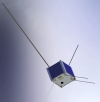
|
Lituanica
OSCAR-78
LO-78
LituanicaSAT-1
#39569
(1998-067EN) |
LituanicaSAT-1
is together with LitSat-1 one of the two the first Lithuanian
satellites. The Kaunas University of Technology developed
LituanicaSAT-1 with members of the Vilnius
University Amateur Radio Club being involved. The satellite
used low cost open-source software and hardware for
primary and secondary flight computers that controlled
the payload consisting of an onboard VGA camera, GPS
receiver, UHF CW beacon 100mW, 9k6 AX25 FSK telemetry
TX 2 watts and FM Mode V/U transponder 150mW Voice Repeater.
The IARU coordinated frequencies are:
- FM
Transponder: Uplink 145.950 MHz, Downlink 435.180 MHz
- AX25 Uplink 145.850 MHz, AX25 Downlink 437.550
MHz
- CW Beacon 437.275 MHz.
LituanicaSAT-1
was successful deployed from ISS by Astronaut Koichi
Wakata KC5ZTA using a Nanoracks deployment pod and is
operational. LituanicaSat-1 decayed on July 28th
2014. |
Feb
28th 2014 |
 Enclosed
signal of the FM transponder including his own signal
was received on May 1st 2014
at 23:15 UTC on 145.850 MHz by Roland PY4ZBZ. Recording
kindly provided by Roland Zurmely PY4ZBZ. Enclosed
signal of the FM transponder including his own signal
was received on May 1st 2014
at 23:15 UTC on 145.850 MHz by Roland PY4ZBZ. Recording
kindly provided by Roland Zurmely PY4ZBZ.
|
 This QSO
between PU2NGB and PY5LF was recorded on June 5th
2014 during orbit #1522 by Roland PY4ZBZ. Recording
kindly provided by Roland Zurmely PY4ZBZ. This QSO
between PU2NGB and PY5LF was recorded on June 5th
2014 during orbit #1522 by Roland PY4ZBZ. Recording
kindly provided by Roland Zurmely PY4ZBZ.
|
 Roland
PY4ZBZ recorded himself calling CQ on July 1st
2014. Recording kindly provided by Roland Zurmely PY4ZBZ. Roland
PY4ZBZ recorded himself calling CQ on July 1st
2014. Recording kindly provided by Roland Zurmely PY4ZBZ.
|
 Roland
PY4ZBZ recorded enclosed QSO between himself and PY5LF
on July 22nd 2014. At the end
you can hear also the beacon signal in CW and as a female
voice identifying the callsign LY5N. Recording kindly
provided by Roland Zurmely PY4ZBZ. Roland
PY4ZBZ recorded enclosed QSO between himself and PY5LF
on July 22nd 2014. At the end
you can hear also the beacon signal in CW and as a female
voice identifying the callsign LY5N. Recording kindly
provided by Roland Zurmely PY4ZBZ.
|
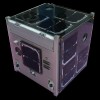
|
SPROUT
#39770
(2014-029E) |
SPROUT is a Japanse Cubesat
with a weight of 7.1 kg. It was launched piggyback on
ALOS-2 (Advanced Land Observing Satellite - 2) on May
24th 2014 at 03:05 UTC from
Tanegashima Space Center into a sun synchronous orbit
with a height of 654km.
SPROUT provides the following operating
modes:
- CW 437.525 MHz, 110mW, A1A
- FM packet
437.525 MHz, 450mW, F2D, AX.25
- SSTV437.600 MHz,
450mW, F3F
- Digi-talker, Message box, Camera downlink
437.600 MHz, 450mW |
May
24th 2014 |
 The first
who reported the reception of the CW beacon was Roland
PY4ZBZ. He received it on May 24th
2014 at 04:00 UTC. Recording kindly provided by Roland
Zurmely PY4ZBZ. The first
who reported the reception of the CW beacon was Roland
PY4ZBZ. He received it on May 24th
2014 at 04:00 UTC. Recording kindly provided by Roland
Zurmely PY4ZBZ.
|
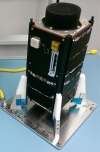
|
European Oscar-79
EO-79
QB50P1
FunCube-3
#40025
(2014-033R) |
QB50P2 was built
and launched as a joint effort of the van Karman institute
and ISIS. It was launched together with 36
other satellites on a Russian Dnepr rocket on Thursday,
June 19th 2014
at 19:11h UTC from Dombarovsky in Southern Russia. QB50P1
carries an Ion and Neutral Mass Spectrometer, an attitude
control experiment, a thermocouple to monitor the spacecraft’s
temperature and FUNCube-3, an amateur radio transponder
system by AMSAT-UK and AMSAT-NL. Frequencies are
as follows:
145.815 MHz 1200bd BPSK or CW telemetry
145.935 - 145.965 MHz Inverting USB transponder downlink
435.047 - 435.077 MHz Inverting LSB transponder uplink
The output power is approx. 400mW. |
June
19th 2014 |
  Davide
IW0HLG received the 1200bd BPSK signal of EO-79 on July
21st 2014 at 09:51 UTC on 145.815
MHz. Recording and waterfall plot kindly provided by
Davide IW0HLG. Davide
IW0HLG received the 1200bd BPSK signal of EO-79 on July
21st 2014 at 09:51 UTC on 145.815
MHz. Recording and waterfall plot kindly provided by
Davide IW0HLG.
|
 Francisco
EA7ADI received the 1200bd BPSK signal of EO-79 on March
1st 2015 at 10:02 UTC. Recording
kindly provided by Francisco EA7ADI. Francisco
EA7ADI received the 1200bd BPSK signal of EO-79 on March
1st 2015 at 10:02 UTC. Recording
kindly provided by Francisco EA7ADI.
|
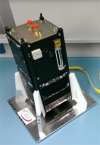
|
European Oscar-80
EO-80
QB50P2
#40032
(2014-033Y) |
QB50P2 was built
and launched as a joint effort of the van Karman institute
and ISIS. It was launched together with 36 other satellites
on a Russian Dnepr rocket on Thursday, June 19th 2014
at 19:11h UTC from Dombarovsky in Southern Russia. QB50P2
carries the same attitude control system and thermocouple
as QB50P1, combining them with a French amateur radio
system (FM transponder) and the FIPEX experiment for
the Technical University of Dresden, which will study
the oxygen flux in the satellite’s environment. Frequencies
are as follows:
145.880 MHz 1200bd BPSK or CW telemetry
145.840 MHz 9600bd FSK
tbd Voice Repeater Downlink |
June
19th 2014 |
  Davide
IW0HLG received the 1200bd BPSK signal of EO-80 on July
22nd 2014 at 09:36 UTC on 145.880
MHz. Recording and waterfall plot kindly provided by
Davide IW0HLG. Davide
IW0HLG received the 1200bd BPSK signal of EO-80 on July
22nd 2014 at 09:36 UTC on 145.880
MHz. Recording and waterfall plot kindly provided by
Davide IW0HLG.
|
 Francisco
EA7ADI received the 1200bd BPSK signal of EO-80 on April
11th 2015 at 10:07 UTC. Recording
kindly provided by Francisco EA7ADI. Francisco
EA7ADI received the 1200bd BPSK signal of EO-80 on April
11th 2015 at 10:07 UTC. Recording
kindly provided by Francisco EA7ADI.
|
 Francisco
EA7ADI received the 1200bd BPSK signal of EO-80 also
on April 26th 2015 at 10:23
UTC. Recording kindly provided by Francisco EA7ADI. Francisco
EA7ADI received the 1200bd BPSK signal of EO-80 also
on April 26th 2015 at 10:23
UTC. Recording kindly provided by Francisco EA7ADI.
|
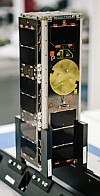
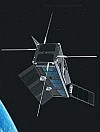
|
UKube-1
FunCube-2
#40074
(2014-037F) |
UKube-1 (United Kingdom
Universal Bus Experiment 1) is Scotland's first space
satellite. It was designed and manufactured by Clyde
Space in Glasgow. Ukube-1,
part of the UK's national collaborative CubeSat program,
will test several new technologies in space. Payloads
on UKube-1 include:
- TOPCAT, from the
University of Bath, is the first GPS device aimed at
measuring plasmaspheric space weather
- The
CMOS Image Demonstrator by the Open University is a
camera that will take images of the earth and test the
effect of radiation on space hardware using a new generation
of image sensor
- Astrium’s
“Janus” Experiment to demonstrate the feasibility of
using cosmic radiation to improve the security of communications
satellites and to flight test lower cost electronic
systems
- AMSAT’s
FUNcube-2, an outreach payload allowing school children
of primary and secondary age to interact with the spacecraft.
It features a CW downlink on 145.830 MHz, a telemetry
downlink at 145.915 MHz as well as a 435 MHz / 145 MHz
linear transponder. |
July
8th 2014 |
  Davide
IW0HLG received the CW signal of UKube-1 on December
12th 2014 at 21:30 UTC on 145.480
MHz. Recording and waterfall plot kindly provided by
Davide IW0HLG. Davide
IW0HLG received the CW signal of UKube-1 on December
12th 2014 at 21:30 UTC on 145.480
MHz. Recording and waterfall plot kindly provided by
Davide IW0HLG.
|
  Davide
IW0HLG received the 1200bd BPSK signal of FunCube-2
on December 13th 2014 at 09:52
UTC on 145.915 MHz. Recording and waterfall plot kindly
provided by Davide IW0HLG. Davide
IW0HLG received the 1200bd BPSK signal of FunCube-2
on December 13th 2014 at 09:52
UTC on 145.915 MHz. Recording and waterfall plot kindly
provided by Davide IW0HLG.
|
 Francisco
EA7ADI received the CW signal of UKUBE-1 on April 2nd
2015 at 10:34 UTC. Recording kindly provided by Francisco
EA7ADI. Francisco
EA7ADI received the CW signal of UKUBE-1 on April 2nd
2015 at 10:34 UTC. Recording kindly provided by Francisco
EA7ADI.
|
 Francisco
EA7ADI received the CW signal of UKUBE-1 again on May
9th2015 at 10:38 UTC. Recording
kindly provided by Francisco EA7ADI. Francisco
EA7ADI received the CW signal of UKUBE-1 again on May
9th2015 at 10:38 UTC. Recording
kindly provided by Francisco EA7ADI.
|

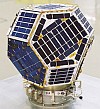
|
Fuji
OSCAR-82
FO-82
Shin-En2
JG6YIG
#40320
(2014-076B) |
Shin-En
2 was launched with Hayabusa-2 from Japan on Dec. 3rd 2014
on an Earth escape trajectory. Shin-En 2 has a polyhedral
shape, a weight of 15 kg and carries three Communications
lines:
Line A is a Communications experiment with
an uplink at 145.942 MHz and a downlink at 435.270 MHz
(0.4 Watts). The modulation format is F1D (10bps, FSK,
manchester encoded).
Line B is a A1A (CW, dits 1
sec, long points 3 sec, puase 1 sec) beacon transmitting
on 437.505 MHz (0.1 Watts) using the callsign JG6YIG
Line C is the Command up and downlink to control the
operation of the spacecraft. Uplink is in 2m band (F2D,
AFSK)) and downlink is at 437.385 MHz (0.8 Watts) in
F1D (FSK).
The satellite will orbit the sun in an
elliptic orbit between Venus and Mars. Its
inclination will stay almost zero. |
Dec.
3rd
2014 |
 Rob
Hardenberg received the signal from Shin-en2 on December
4th 2014 at 23:39 UTC on 437.385
MHz. At that time Shin-en2 was at a distance of
750 000 km. Spectrum plot kindly provided by Rob PE1ITR. Rob
Hardenberg received the signal from Shin-en2 on December
4th 2014 at 23:39 UTC on 437.385
MHz. At that time Shin-en2 was at a distance of
750 000 km. Spectrum plot kindly provided by Rob PE1ITR.
|
 Rob Hardenberg
received the signal from Shin-en2 also on December 3rd
2014 at 22:01 UTC on 437.377 MHz. Audio recording kindly
provided by Rob PE1ITR. Rob Hardenberg
received the signal from Shin-en2 also on December 3rd
2014 at 22:01 UTC on 437.377 MHz. Audio recording kindly
provided by Rob PE1ITR.
|
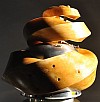
|
Fuji
OSCAR-81
FO-81
Artsat-Despatch
ARTSAT-2
#40321
(2014-076C) |
ARTSAT
- DESPATCH (ART and SATellite Project - DEep SPace Amateur
Troubadour’s CHallenge) was launched with Hayabusa-2
from Japan on Dec. 3rd 2014
on an Earth escape trajectory. This spacecraft is 50x50x45
cm in size , has a mass of 32 kg and has a helix-shaped
segment making it a beautiful sculpture. ARTSAT is also
called Fuji OSCAR 81 and features a 7 Watt CW beacon
transmitting on 437.325 MHz. |
Dec.
3rd
2014 |
 Rob
Hardenberg received the signal from ARTSAT-2 on December
4th 2014 at 00:00 UTC on 437.3179
MHz. At that time ARTSAT-2 was at a distance of
730 000 km. Spectrum plot kindly provided by Rob PE1ITR. Rob
Hardenberg received the signal from ARTSAT-2 on December
4th 2014 at 00:00 UTC on 437.3179
MHz. At that time ARTSAT-2 was at a distance of
730 000 km. Spectrum plot kindly provided by Rob PE1ITR.
|
 Enclosed
audio file of ARTSAT-DESPATCH was recorded on December
3rd 2014 at 16:45 UTC while
Artsat-Despatch was at a distance from Earth of 200
000 km. You can hear the telemetry downlink signal in
very slow baudot coding. Recording kindly provided by
Akihiro Kubota-san on behalf of the ARTSAT project team. Enclosed
audio file of ARTSAT-DESPATCH was recorded on December
3rd 2014 at 16:45 UTC while
Artsat-Despatch was at a distance from Earth of 200
000 km. You can hear the telemetry downlink signal in
very slow baudot coding. Recording kindly provided by
Akihiro Kubota-san on behalf of the ARTSAT project team.
|
 This
is another recording of the telemetry signal of ARTSAT-DESPATCH
recorded about one hour later on December 3rd
2014 at 17:40 UTC. Recording kindly provided by Akihiro
Kubota-san on behalf of the ARTSAT project team. This
is another recording of the telemetry signal of ARTSAT-DESPATCH
recorded about one hour later on December 3rd
2014 at 17:40 UTC. Recording kindly provided by Akihiro
Kubota-san on behalf of the ARTSAT project team.
|

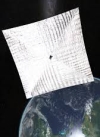

|
LightSail-1
LightSail A
#40661
(2015-025L) |
On Wednesday, May
20th 2015
at 15:04 UTCthe first of The Planetary Society’s two
LightSail spacecraft blasted off into space aboard an
Atlas V rocket with the X-37B space shuttle. There were
ten CubeSats including LightSail-1 in the UltraSat Deployer
onboard the Atlas V:
• GEARRSAT 2 (GEARRS
2)
• LightSail A
• OptiCube 1 (O/C 1)
•
OptiCube 2 (O/C 2)
• OptiCube 3 (O/C 3)
• USS
Langley
• AeroCube 8A (IMPACT A)
• AeroCube
8B (IMPACT B)
• BRICSat-P
• PSat A (ParkinsonSat
A)
LightSail-1
is a 3U cubesat with a weight of 5 kg. It has a 9600
bps FSK AX.25 Packet Radio downlink on 437.435 MHz using
the callsign KK6HIT.
Lightsail became
operational but had 2 failures which resulted in a loss
of communication in the first 2 weeks. However it came
back again each time. The deployment of the solar cells
was successful. The deployment of the solar sail started
on June 7th 2015
at 19:47 UTC. Lightsail-1's reentry occurred on July
15th 2015
around 17:23 UTC near the South Atlantic Ocean. |
May
20th 2015 |
 Mike
DK3WN received the 9600bd signal of LightSail-1 on June
10th 2015 at 05:50 UTC. Recording
kindly provided by Mike DK3WN. Mike
DK3WN received the 9600bd signal of LightSail-1 on June
10th 2015 at 05:50 UTC. Recording
kindly provided by Mike DK3WN.
|
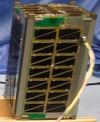
|
Naval
Academy OSCAR 84
NO-84
PSAT-1
PSat A
ParkinsonSat A
#40654
(2015-025D) |
The PSAT Project
(ParkinsonSAT) has been developed by students at the
US Naval Academy Satellite Lab as a two-way communications
transponder system that could be used to relay data
from remote terminals to a global network of internet
linked ground stations. The PSAT-1 satellite hosts an
AX.25 Packet Radio Relay system based on the Automatic
Packet Reporting System using the standard VHF 145.825
MHz frequency for up and downlink. PSAT-1 is based on
the 1.5U form factor using solar cells for power generation
and a 10-Watt-hour battery. In addition to the APRS
system, the PSAT spacecraft is equipped with a PSK31
transponder that allows multi-user access to the satellite.
This text messaging transponder can allow messaging
between 30 ground stations simultaneously. The PSK31
uplink for PSat-A is at 28.120MHz (SSB), the corresponding
downlink is at 435.350MHz (FM with PSK31 subcarriers)
with
the telemetry at the subcarrier of 315 Hz. |
May
20th 2015 |
 Francisco
EA7ADI received the AX-25 packet radio downlink of PSAT-1
on 145.825 MHz on May 30th2015
at 08:30 UTC. Recording kindly provided by Francisco
EA7ADI. Francisco
EA7ADI received the AX-25 packet radio downlink of PSAT-1
on 145.825 MHz on May 30th2015
at 08:30 UTC. Recording kindly provided by Francisco
EA7ADI.
|
  Francisco
EA7ADI received the PSK31 downlink of PSAT-1 on 435.350
MHz on May 31st2015 at 17:12
UTC. He used a ICOM IC-7000 and a home made 7 element
cross YAGI antenna. Recording and spectrum plot kindly
provided by Francisco EA7ADI. Francisco
EA7ADI received the PSK31 downlink of PSAT-1 on 435.350
MHz on May 31st2015 at 17:12
UTC. He used a ICOM IC-7000 and a home made 7 element
cross YAGI antenna. Recording and spectrum plot kindly
provided by Francisco EA7ADI.
|

|
Naval
Academy OSCAR 83
NO-83
BRICsat-P
#40655
(2015-025E) |
NO-83 BRICsat-P
(Ballistic Reinforced Communication Satellite) is a
low cost 1.5U CubeSat built by the US Naval Academy
Satellite Lab in collaboration with George Washington
University. Its main mission is to demonstrate on-orbit
operation of a Micro-Cathode Arc Thruster (µCAT)
electric propulsion system.
In addition it carries
an Amateur Radio communication payload. The
PSK31 uplink for BRICsat is at 28.120MHz (SSB), the
PSK downlink is at 435.350MHz (FM with PSK31 subcarriers)
with the telemetry at the subcarrier of 375 Hz. BRICsat
also features a
9600 bps FSK AX.25 Packet Radio telemetry downlink on
437.975 MHz which transmits every 20 seconds.
BRICSAT telemetry has been heard but is cycling OFF
due to low power. |
May
20th 2015 |
 Mike
DK3WN received the 9600bd telemetry signal of NO-83
on June 30th 2015 at 18:30
UTC. Recording kindly provided by Mike DK3WN. Mike
DK3WN received the 9600bd telemetry signal of NO-83
on June 30th 2015 at 18:30
UTC. Recording kindly provided by Mike DK3WN.
|
 During
the same pass on June 30th
2015 at 18:30 UTC Mike DK3WN received also the PSK31
downlink signal of NO-83 . Recording kindly provided
by Mike DK3WN. During
the same pass on June 30th
2015 at 18:30 UTC Mike DK3WN received also the PSK31
downlink signal of NO-83 . Recording kindly provided
by Mike DK3WN.
|
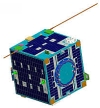
|
XW-2A
XiWang 2A
CAS-3A
Hope 2A
#40903
(2015-049E) |
CAS-3A
to CAS-3I were launched on a Long March 6 (CZ-6) rocket
on September 19th 2015 at 23:01:14
UTC. Click on the picture below to get an enlarged frequency
band plan of XW-2A to XW-2F.

This is waterfall
diagram showing the various downlink signals of the
CAS-satellites. The diagram was recorded on September
22nd 2015 at 17:21 UTC. Please
ignore the interference signal at 145.860 MHz.
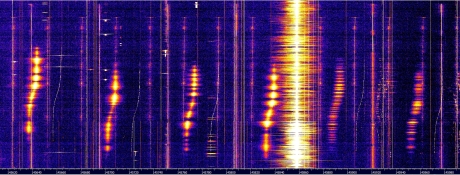
CAS-3A is a
micro-satellite with the dimensions 398mmx398mmx398mm
and a mass of approx. 25 kg.
XW-2A also called CAS-3A
(Chinese Amateur Satellite) features the following modi:
Digital Telemetry: 145.640 MHz,
20 dBm, 9.6/19.2kbps, GMSK
CW Beacon: 145.660
MHz, 17 dBm, 22wpm, CW
Inverting Linear Transponder:
Uplink:
435.030 - 435.050 MHz
Downlink:
145.665 - 145.685 MHz,
20 dBm |
Sept
19th 2015 |
 The CW
beacon of CAS-3A was received on September 20th
2015 at 16:04 UTC on 145.662 MHz in USB. Recorded by
Matthias DD1US. The CW
beacon of CAS-3A was received on September 20th
2015 at 16:04 UTC on 145.662 MHz in USB. Recorded by
Matthias DD1US.
|
 The GMSK
downlink of CAS-3A was received on September 20th
2015 at 16:05 UTC on 145.641 MHz in USB. Recorded by
Matthias DD1US. The GMSK
downlink of CAS-3A was received on September 20th
2015 at 16:05 UTC on 145.641 MHz in USB. Recorded by
Matthias DD1US.
|
 Francisco
EA7ADI received the CW downlink of XW-2A on 145.660
MHz on September 25th2015 at
18:17 UTC. Recording kindly provided by Francisco EA7ADI. Francisco
EA7ADI received the CW downlink of XW-2A on 145.660
MHz on September 25th2015 at
18:17 UTC. Recording kindly provided by Francisco EA7ADI.
|
  Francisco
EA7ADI received the CW downlink of XW-2A on 145.660
MHz on September 27th2015 at
17:46 UTC. Recording kindly provided by Francisco EA7ADI. Francisco
EA7ADI received the CW downlink of XW-2A on 145.660
MHz on September 27th2015 at
17:46 UTC. Recording kindly provided by Francisco EA7ADI.
|
 On December
27th 2015 at 21:37 UTC the
19k2 downlink signal of XW-2A was received and recorded
by Noguchi-san JA5BLZ. Recording kindly provided by
Tetsu-san JA0CAW. On December
27th 2015 at 21:37 UTC the
19k2 downlink signal of XW-2A was received and recorded
by Noguchi-san JA5BLZ. Recording kindly provided by
Tetsu-san JA0CAW.
|
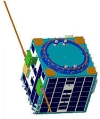 |
XW-2B
CAS-3B
#40911
(2015-049N) |
CAS-3A
to CAS-3I were launched on a Long March 6 (CZ-6) rocket
on September 19th 2015 at 23:01:14
UTC. CAS-3B is a micro-satellite with the dimensions
246mmx246mmx246mm and a mass of approx. 10 kg.
XW-2B
features the following modi:
Digital Telemetry:
145.705 MHz,
20 dBm, 9.6/19.2kbps, GMSK
CW Beacon: 145.725 MHz, 17
dBm, 22wpm, CW
Inverting Linear Transponder:
Uplink:
435.090 - 435.110 MHz
Downlink:
145.730 - 145.750 MHz,
20 dBm |
Sept
19th 2015 |
 The CW
beacon of CAS-3B was received on September 20th
2015 at 16:07 UTC on 145.728 MHz in USB. Recorded by
Matthias DD1US. The CW
beacon of CAS-3B was received on September 20th
2015 at 16:07 UTC on 145.728 MHz in USB. Recorded by
Matthias DD1US.
|
 The GMSK
downlink of CAS-3B was received on September 20th
2015 at 16:06 UTC on 145.705 MHz in USB. Recorded by
Matthias DD1US. The GMSK
downlink of CAS-3B was received on September 20th
2015 at 16:06 UTC on 145.705 MHz in USB. Recorded by
Matthias DD1US.
|
 On November
30th 2015 at 21:15 UTC the
19k2 downlink signal of XW-2B was received and recorded
by Kuge-san JE1CVL. Recording kindly provided by Tetsu-san
JA0CAW. On November
30th 2015 at 21:15 UTC the
19k2 downlink signal of XW-2B was received and recorded
by Kuge-san JE1CVL. Recording kindly provided by Tetsu-san
JA0CAW.
|
 |
XW-2C
XiWang 2C
CAS-3C
Hope 2C
#40906
(2015-049H) |
CAS-3A
to CAS-3I were launched on a Long March 6 (CZ-6) rocket
on September 19th 2015 at 23:01:14
UTC. CAS-3C is a micro-satellite with the dimensions
246mmx246mmx246mm and a mass of approx. 10 kg.
XW-2C
features the following modi:
Digital Telemetry:
145.770 MHz, 20 dBm, 9.6/19.2kbps, GMSK
CW Beacon: 145.790 MHz, 17
dBm, 22wpm, CW
Inverting Linear Transponder:
Uplink:
435.150 - 435.170 MHz
Downlink:
145.795 - 145.815 MHz,
20 dBm |
Sept
19th 2015 |
 The CW
beacon of CAS-3C was received on September 20th
2015 at 16:07 UTC on 145.790MHz in USB. Recorded by
Matthias DD1US. The CW
beacon of CAS-3C was received on September 20th
2015 at 16:07 UTC on 145.790MHz in USB. Recorded by
Matthias DD1US.
|
 The CW
beacon of CAS-3C was received on September 20th
2015 at 17:42 UTC on 145.788 MHz in USB. Recorded by
Matthias DD1US. The CW
beacon of CAS-3C was received on September 20th
2015 at 17:42 UTC on 145.788 MHz in USB. Recorded by
Matthias DD1US.
|
 The GMSK
downlink of CAS-3C was received on September 20th
2015 at 16:08 UTC on 145.770 MHz in USB. Recorded by
Matthias DD1US. The GMSK
downlink of CAS-3C was received on September 20th
2015 at 16:08 UTC on 145.770 MHz in USB. Recorded by
Matthias DD1US.
|
 Francisco
EA7ADI received the CW downlink of XW-2C on 145.790
MHz on September 24th2015 at
16:54 UTC. Recording kindly provided by Francisco EA7ADI. Francisco
EA7ADI received the CW downlink of XW-2C on 145.790
MHz on September 24th2015 at
16:54 UTC. Recording kindly provided by Francisco EA7ADI.
|
 On December
22nd 2015 at 23:24 UTC the
19k2 downlink signal of XW-2C was received and recorded
by Noguchi-san JA5BLZ. Recording kindly provided by
Tetsu-san JA0CAW. On December
22nd 2015 at 23:24 UTC the
19k2 downlink signal of XW-2C was received and recorded
by Noguchi-san JA5BLZ. Recording kindly provided by
Tetsu-san JA0CAW.
|
 |
XW-2D
XiWang 2D
CAS-3D
Hope 2D
#40907
(2015-049J) |
CAS-3A
to CAS-3I were launched on a Long March 6 (CZ-6) rocket
on September 19th 2015 at 23:01:14
UTC. CAS-3D is a micro-satellite with the dimensions
246mmx246mmx246mm and a mass of approx. 10 kg.
XW-2D
features the following modi:
Digital Telemetry:
145.835 MHz,
20 dBm, 9.6/19.2kbps, GMSK
CW Beacon:
145.855 MHz,
17 dBm, 22wpm, CW
Inverting Linear
Transponder:
Uplink:
435.210 - 435.230 MHz
Downlink:
145.860 - 145.880 MHz, 20
dBm |
Sept
19th 2015 |
 The CW
beacon of CAS-3D was received on September 20th
2015 at 16:09 UTC on 145.853 MHz in USB. Recorded by
Matthias DD1US. The CW
beacon of CAS-3D was received on September 20th
2015 at 16:09 UTC on 145.853 MHz in USB. Recorded by
Matthias DD1US.
|
 The GMSK
downlink CAS-3D was received on September 20th
2015 at 16:09 UTC on 145.835 MHz in USB. Recorded by
Matthias DD1US. The GMSK
downlink CAS-3D was received on September 20th
2015 at 16:09 UTC on 145.835 MHz in USB. Recorded by
Matthias DD1US.
|
 On December
26th 2015 at 21:20 UTC the
19k2 downlink signal of XW-2D was received and recorded
by Noguchi-san JA5BLZ. Recording kindly provided by
Tetsu-san JA0CAW. On December
26th 2015 at 21:20 UTC the
19k2 downlink signal of XW-2D was received and recorded
by Noguchi-san JA5BLZ. Recording kindly provided by
Tetsu-san JA0CAW.
|
 |
XW-2E
XiWang 2E
CAS-3E
Hope 2E
#40909
(2015-049L) |
CAS-3A
to CAS-3I were launched on a Long March 6 (CZ-6) rocket
on September 19th 2015 at 23:01:14
UTC. CAS-3E is a picosatellite with the dimensions 116mmx116mmx116mm
and a weight of approx. 1.5kg.
XW-2E features the
following modi:
Digital Telemetry: 145.890 MHz, 20
dBm, 9.6kbps, GMSK
CW Beacon: 145.910 MHz, 17
dBm, 22wpm, CW
Inverting Linear Transponder:
Uplink:
435.270 - 435.290 MHz
Downlink:
145.915 - 145.935 MHz,
20 dBm |
Sept
19th 2015 |
 The CW
beacon of CAS-3E was received on September 20th
2015 at 16:10 UTC on 145.907 MHz in USB. Recorded by
Matthias DD1US. The CW
beacon of CAS-3E was received on September 20th
2015 at 16:10 UTC on 145.907 MHz in USB. Recorded by
Matthias DD1US.
|
 The GMSK
downlink of CAS-3E was received on September 20th
2015 at 16:11 UTC on 145.886 MHz in USB. Recorded by
Matthias DD1US. The GMSK
downlink of CAS-3E was received on September 20th
2015 at 16:11 UTC on 145.886 MHz in USB. Recorded by
Matthias DD1US.
|
 The linear
transponder downlink of CAS-3E was received on September
20th 2015 at 17:41 UTC on 145.931
MHz in USB. You can hear F4EJN calling CQ. Recorded
by Matthias DD1US. The linear
transponder downlink of CAS-3E was received on September
20th 2015 at 17:41 UTC on 145.931
MHz in USB. You can hear F4EJN calling CQ. Recorded
by Matthias DD1US.
|
 Francisco
EA7ADI received the CW downlink of XW-2E on 145.910
MHz on September 25th2015 at
18:28 UTC. Recording kindly provided by Francisco EA7ADI. Francisco
EA7ADI received the CW downlink of XW-2E on 145.910
MHz on September 25th2015 at
18:28 UTC. Recording kindly provided by Francisco EA7ADI.
|
 Francisco
EA7ADI received the CW downlink of XW-2E on 145.910
MHz on September 27th2015 at
18:02 UTC. Recording kindly provided by Francisco EA7ADI. Francisco
EA7ADI received the CW downlink of XW-2E on 145.910
MHz on September 27th2015 at
18:02 UTC. Recording kindly provided by Francisco EA7ADI.
|
 |
XW-2F
XiWang 2F
CAS-3F
Hope 2F
#40910
(2015-049M) |
CAS-3A
to CAS-3I were launched on a Long March 6 (CZ-6) rocket
on September 19th 2015 at 23:01:14
UTC. CAS-3F is a picosatellite with the dimensions 116mmx116mmx116mm
and a weight of approx. 1.5kg.
XW-2FA features the
following modi:
Digital Telemetry: 145.955 MHz, 20
dBm, 9.6kbps, GMSK
CW Beacon: 145.975 MHz, 17
dBm, 22wpm, CW
Inverting Linear Transponder:
Uplink:
435.330 - 435.350 MHz
Downlink:
145.980 - 146.000 MHz,
20 dBm |
Sept
19th 2015 |
 The CW
beacon of CAS-3F was received on September 20th
2015 at 16:13 UTC on 145.972 MHz in USB. Recorded by
Matthias DD1US. The CW
beacon of CAS-3F was received on September 20th
2015 at 16:13 UTC on 145.972 MHz in USB. Recorded by
Matthias DD1US.
|
 The linear
transponder downlink of CAS-3F was received on September
20th 2015 at 17:40 UTC on 145.990
MHz in USB. You can hear EA1GM calling CQ. Recorded
by Matthias DD1US. The linear
transponder downlink of CAS-3F was received on September
20th 2015 at 17:40 UTC on 145.990
MHz in USB. You can hear EA1GM calling CQ. Recorded
by Matthias DD1US.
|
 Francisco
EA7ADI received the CW downlink of XW-2F on 145.975
MHz on September 27th2015 at
18:08 UTC. Recording kindly provided by Francisco EA7ADI. Francisco
EA7ADI received the CW downlink of XW-2F on 145.975
MHz on September 27th2015 at
18:08 UTC. Recording kindly provided by Francisco EA7ADI.
|
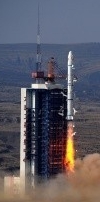 |
DCBB
CAS-3G
#40912
(2015-049P) |
CAS-3A
to CAS-3I were launched on a Long March 6 (CZ-6) rocket
on September 19th 2015 at 23:01:14
UTC. CAS-3G is a 2U Cubesat which was ejected from its
mother satellite Xinjishu Yanzheng 2 on September 20th
2015.
DCBB features the following modi:
Digital
Telemetry: 145.475 MHz,
9.6kbps, GMSK
Digital Telemetry: 437.950 MHz, 9.6kbps,
GMSK |
Sept
19th 2015 |
 The GMSK
downlink of CAS-3G was received on September 20th
2015 at 17:37 UTC on 145.475 MHz in FM. Recorded by
Matthias DD1US. The GMSK
downlink of CAS-3G was received on September 20th
2015 at 17:37 UTC on 145.475 MHz in FM. Recorded by
Matthias DD1US.
|
 Francisco
EA7ADI received the 9k6 GMSK downlink of DCBB on 145.475
MHz on September 30th2015 at
17:20 UTC. He demodulated the signal in USB and FM.
First half of enclosed recording of the downlink signal
was in USB, second half in FM. Kindly provided by Francisco
EA7ADI. Francisco
EA7ADI received the 9k6 GMSK downlink of DCBB on 145.475
MHz on September 30th2015 at
17:20 UTC. He demodulated the signal in USB and FM.
First half of enclosed recording of the downlink signal
was in USB, second half in FM. Kindly provided by Francisco
EA7ADI.
|
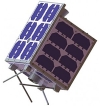

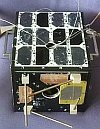
|
LilacSat-2
CAS-3H
#40908
(2015-049K) |
LilacSat-2
was launched on a Long March 6 (CZ-6) rocket on September
19th 2015 at 23:01:14 UTC.
CAS-3H is a low cost nano-satellite with the dimensions
200mmx200mmx200mm and a weight of approx. 11kg.
LilacSat-2 features the following modi:
CW Beacon 437.200
MHz
APRS: Uplink: 144.390 MHz AFSK
Downlink:
144.390 MHz,
AFSK
FM Transponder:
Uplink: 144.350 MHz, FM
Downlink: 437.225
MHz, FM
SSB/CW non-inverting transponder, 40 kHz
wide:
Uplink: 144.3425
... 144.3825 MHz,
SSB/CW
Downlink: 437.180
... 437.220 MHz, SSB/CW |
Sept
19th 2015 |
 The GMSK
downlink of CAS-3H was received on September 20th
2015 at 17:43 UTC on 437.200 MHz in FM. Recorded by
DD1US. The GMSK
downlink of CAS-3H was received on September 20th
2015 at 17:43 UTC on 437.200 MHz in FM. Recorded by
DD1US.
|
  On
the transponder downlink on 437.246 MHz enclosed signal
was received on September 20th
2015 at 17:50 UTC in USB. It is most likely someone
testing the transponder. Left to the FM transponder
downlink you can also see one burst of the beacon signal.
Recorded by DD1US. On
the transponder downlink on 437.246 MHz enclosed signal
was received on September 20th
2015 at 17:50 UTC in USB. It is most likely someone
testing the transponder. Left to the FM transponder
downlink you can also see one burst of the beacon signal.
Recorded by DD1US.
|
 On
September 24th 2015 student
team at Harbin Institute of Technology downloaded the
first infrared image taken by LilacSat-2. On
September 24th 2015 student
team at Harbin Institute of Technology downloaded the
first infrared image taken by LilacSat-2.
|
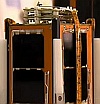 |
NUDT-Phone-Sat CAS-3I
Kaituo
1B
#40900
(2015-049B) |
CAS-3A
to CAS-3I were launched on a Long March 6 (CZ-6) rocket
on September 19th 2015 at 23:01:14
UTC. CAS-3I is an experimental pico satellite with a
weight of 1kg developed by NUDT (National University
of Defense Technology) and CAMSAT.
NUDT-Phone-Sat
features the following downlink:
Digital Telemetry: 437.300
MHz, 9.6kbps, FSK |
Sept
19th 2015 |
 Francisco
EA7ADI received the 9k6 FSK downlink of NUDT-Phone-Sat
on 437.300 MHz on September 27th2015
at 17:50 UTC. Recording kindly provided by Francisco
EA7ADI. Francisco
EA7ADI received the 9k6 FSK downlink of NUDT-Phone-Sat
on 437.300 MHz on September 27th2015
at 17:50 UTC. Recording kindly provided by Francisco
EA7ADI.
|
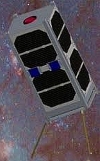
|
TW-1A
TianWang1A
SECM-1
Shankeda 2
#40928
(2015-051D) |
A Chinese 2U Cubesat
lanuched into a 470km x 485km orbit with an inclination
of 97.3°. Telemetry downlink is 435.645 MHz GMSK
4800/9600 CSP, TX interval 10 sec. It is planned to
demonstrate formation flying with inter satellite communication
using GAMALINK 2.4 GHz spread spectrum at 1Mbps and
CSP (CubeSat Space Protocol). |
Sept
25th 2015 |
  On
the telemetry downlink on 435.645 MHz enclosed signal
was received on September 26th
2015 at 18:11 UTC in FM. One can see that there are
2 downlink signals, most likely from TW-1A and TW-1C.
The short time offset between the transmissions suggests
that the 2 satellites are communicating with each other.
Recorded by DD1US. On
the telemetry downlink on 435.645 MHz enclosed signal
was received on September 26th
2015 at 18:11 UTC in FM. One can see that there are
2 downlink signals, most likely from TW-1A and TW-1C.
The short time offset between the transmissions suggests
that the 2 satellites are communicating with each other.
Recorded by DD1US.
|
 Francisco
EA7ADI received the 4800/9600bd GMSK signal of TW-1A
on July 5th 2016 at 19:15 UTC
on 435.645 MHz. Recording kindly provided by Francisco
EA7ADI. Francisco
EA7ADI received the 4800/9600bd GMSK signal of TW-1A
on July 5th 2016 at 19:15 UTC
on 435.645 MHz. Recording kindly provided by Francisco
EA7ADI.
|
 Jan PE0SAT
received the 9600bd GMSK downlink signal of TW-1A on
September 24th 2016 at 16:55
UTC on 435.650 MHz. Recording kindly provided by Jan
van Gils PE0SAT. Jan PE0SAT
received the 9600bd GMSK downlink signal of TW-1A on
September 24th 2016 at 16:55
UTC on 435.650 MHz. Recording kindly provided by Jan
van Gils PE0SAT.
|


|
TW-1B
TianWang1B
NJUST-2
#40927
(2015-051C) |
A Chinese
2U Cubesat lanuched into a 470km x 485km orbit with
an inclination of 97.3°. Telemetry downlink is 437.645
MHz GMSK 4800/9600 CSP, TX interval 20 sec.
I am searching for sound files. Please
send them to
 |
Sept 25th
2015 |
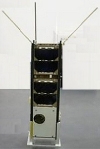
|
TW-1C
TianWang1C
NJFA-1
#40926
(2015-051B) |
A Chinese
3U Cubesat lanuched into a 470km x 485km orbit with
an inclination of 97.3°. Telemetry downlink is 435.645
MHz GMSK 4800/9600 CSP, TX interval 10 sec. |
Sept
25th 2015 |
  On
the telemetry downlink on 435.645 MHz enclosed signal
was received on September 26th
2015 at 18:11 UTC in FM. One can see that there are
2 downlink signals, most likely from TW-1A and TW-1C.
The short time offset between the transmissions suggests
that the 2 satellites are communicating with each other.
Recorded by DD1US. On
the telemetry downlink on 435.645 MHz enclosed signal
was received on September 26th
2015 at 18:11 UTC in FM. One can see that there are
2 downlink signals, most likely from TW-1A and TW-1C.
The short time offset between the transmissions suggests
that the 2 satellites are communicating with each other.
Recorded by DD1US.
|
 Francisco
EA7ADI received the 9k6 GMSK signal of TW-1C on February
10th 2016 at 19:47 UTC on 435.645
MHz. He used an IC7000 receiver in USB mode and a 2x6
element cross yagi. Recording kindly provided by Francisco
EA7ADI. Francisco
EA7ADI received the 9k6 GMSK signal of TW-1C on February
10th 2016 at 19:47 UTC on 435.645
MHz. He used an IC7000 receiver in USB mode and a 2x6
element cross yagi. Recording kindly provided by Francisco
EA7ADI.
|
 Jan PE0SAT
received the 9600bd GMSK downlink signal of TW-1C on
September 25th 2016 at 07:43
UTC on 435.636 MHz. Recording kindly provided by Jan
van Gils PE0SAT. Jan PE0SAT
received the 9600bd GMSK downlink signal of TW-1C on
September 25th 2016 at 07:43
UTC on 435.636 MHz. Recording kindly provided by Jan
van Gils PE0SAT.
|
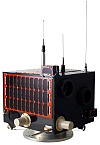
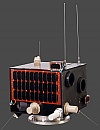
|
Indonesia
Oscar 86
IO-86
LAPAN-A2
LAPAN-ORARI
#40931
(2015-052B) |
LAPAN-A2 satellite
was launched together with AstroSat by an Indian PSLV-C30
rocket into a 650km high orbit with an inclination of
6 to 8 degree. Thus it crosses the territory of Indonesia
14 times a day.
LAPAN A2, also known
as LAPAN-ORARI, is an indonesian microsatellite with
a weight of 74 kg. It is a successor of LAPAN-Tubsat
and the structure
and many subsystems are the same as in its sister satellite
LAPAN A3.
It carries an AIS (Automatic Identification System)
to identify the ships in the waters of Indonesia and
a video camera with a range three times wider than the
Lapan-Tubsat. It also carries a payload for disaster
management by amateur radio communication.
The Earth observation
payload of LAPAN A2 consists of a Video camera (Kappa
PAL) for 80 km width ground coverage and a Video camera
(Kappa HDTV) for high resolution satellite color video
observation with a ground resolution of 6 m and a ground
coverage of 11 × 6 km per video frame.
LAPAN-A2 carries
a payload of voice repeaters and an APRS repeater on
145.825 MHz for communications of the Organisation for
Amateur Radio Indonesia (ORARI) during
a disaster. The APRS repeater is using the callsign
YBOX-1.
The S-Band downlink
at 2220 MHz provides the video signal a data rate of
5 Mbps. The UHF downlink is at 437.425 MHz and provides
TT&C (telemetry tracking and command) functions
at a data rate of 1200bd. The command uplink is also
in the UHF band. |
Sept
28th 2015 |
 IO-86
features a FM voice repeater with an uplink at 145.880
MHz (using a 88,5 Hz CTCSS tone) and a downlink at 435.880
MHz. PY5LF received IO-86 on May 6th
2017 at 16:10 UTC. Recording was kindly provided by
Luciano PY5LF. IO-86
features a FM voice repeater with an uplink at 145.880
MHz (using a 88,5 Hz CTCSS tone) and a downlink at 435.880
MHz. PY5LF received IO-86 on May 6th
2017 at 16:10 UTC. Recording was kindly provided by
Luciano PY5LF.
|

|
AAUSAT-5
#40948
(1998-067GZ) |
AAUSat-5
was built by the Aalborg University in Denmark. This
1U Cubesat features a 9k6 GMSK and CW downlink on 437.425
MHz. AAUSat-5 decayed on March 15th
2016. |
Oct.
5th 2015 |
After its successful
launch from ISS first signals were reported on October
5th 2015. |
 Mike
DK3WN received the 9k6 GMSK signal of AAUSAT-5 on October
9th 2015 at 19:10 UTC. Recording
kindly provided by Mike DK3WN. Mike
DK3WN received the 9k6 GMSK signal of AAUSAT-5 on October
9th 2015 at 19:10 UTC. Recording
kindly provided by Mike DK3WN.
|
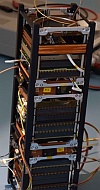
|
GomX-3
#40949
(1998-067HA) |
GomX-3 was built by the
Aalborg University in Denmark. This 3U Cubesat features
a 4k8 bps GMSK downlink on 437.250 MHz using CSP custom
frame data packets with an interval of <10 sec. The
data rate may be changed to up to 19k2 bps. The transmit
power is 1 Watt. It also features an X-band transmitter
with a data rate of 3 Mbps. |
Oct.
5th 2015 |
  After
its successful launch from ISS on October 5th
2015 Roland PY4ZBZ received GomX-3 at 14:36 UTC. Recording
and spectrum plot kindly provided by Roland Zurmely
PY4ZBZ. After
its successful launch from ISS on October 5th
2015 Roland PY4ZBZ received GomX-3 at 14:36 UTC. Recording
and spectrum plot kindly provided by Roland Zurmely
PY4ZBZ.
|
 Francisco
EA7ADI received the 9k6 GMSK signal of GOMX-3 on February
2nd 2016 at 17:45 UTC on 437.250
MHz. He used an IC7000 receiver in USB mode and a 2x6
element cross yagi. Recording kindly provided by Francisco
EA7ADI. Francisco
EA7ADI received the 9k6 GMSK signal of GOMX-3 on February
2nd 2016 at 17:45 UTC on 437.250
MHz. He used an IC7000 receiver in USB mode and a 2x6
element cross yagi. Recording kindly provided by Francisco
EA7ADI.
|
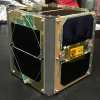
|
AMSAT-OSCAR
85
AO-85
FOX-1A
#40967
(2015-058D) |
FOX-1A is a 1U 1kg Cubesat
featuring an UV-FM-Transponder with an uplink frequency
of 435.180 MHz and a downlink frequency of 145.980 MHz.
Please note that 67 Hz CTCSS tone is to be used
in up- and downlink. The telemetry beacon transmits
with 200 bps approx. 300Hz below the audio spectrum.
The satellite will also test a MEMS Gyro and a low energy
proton experiment. It was successfully launched as part
of the GRACE (Government Rideshare Advanced Concepts
Experiment) auxiliary paypload on the NROP-55 mission
from Vandenburg AFB in USA on an Atlas V vehicle on
October 8th 2015. Signals from
FOX-1A were reported already shortly after launch. |
Oct.
8th 2015 |
 On the
downlink on 145.980 MHz enclosed synthesized voice signals
were received on October 8th
2015 at 20:47 UTC in FM, then SSB, then FM. The signal
was weak as I was using an omni antenna but one can
still hear the voice output identifying the satellite
as "FOX One". Recorded by DD1US. On the
downlink on 145.980 MHz enclosed synthesized voice signals
were received on October 8th
2015 at 20:47 UTC in FM, then SSB, then FM. The signal
was weak as I was using an omni antenna but one can
still hear the voice output identifying the satellite
as "FOX One". Recorded by DD1US.
|
 On October
9th 2015 at 17:54 UTC the FM
transponder was active and quite some activity was audible
including F5VKV calling CQ and having some QSOs. Recorded
by DD1US. On October
9th 2015 at 17:54 UTC the FM
transponder was active and quite some activity was audible
including F5VKV calling CQ and having some QSOs. Recorded
by DD1US.
|
 Francisco
EA7ADI received the FM voice downlink signal of FOX-1A
on February 10th 2016 at 19:31
UTC on 145.980 MHz. Recording kindly provided by Francisco
EA7ADI. Francisco
EA7ADI received the FM voice downlink signal of FOX-1A
on February 10th 2016 at 19:31
UTC on 145.980 MHz. Recording kindly provided by Francisco
EA7ADI.
|
 On July
2nd 2016 at 19:08 UTC Francisco
EA7ADI received the FM Digital Voice Downlink of FOX-1A
on 145.980 MHz. Recording kindly provided by Francisco
EA7ADI. On July
2nd 2016 at 19:08 UTC Francisco
EA7ADI received the FM Digital Voice Downlink of FOX-1A
on 145.980 MHz. Recording kindly provided by Francisco
EA7ADI.
|
 On August
28th 2019 Bernd DL6IAN/p had
a successful contact with IU1KIZ via AO-85. Bernd used
a Kenwood TH-7 handheld TRX wih an output power of 5W
and an Anjo LP-2-70-HH dualband logper antenna. Recording
kindly provided by Bernd DL6IAN. On August
28th 2019 Bernd DL6IAN/p had
a successful contact with IU1KIZ via AO-85. Bernd used
a Kenwood TH-7 handheld TRX wih an output power of 5W
and an Anjo LP-2-70-HH dualband logper antenna. Recording
kindly provided by Bernd DL6IAN.
|

|
HORYU-4
HORYU-IV
AEGIS
#41340
(2016-012D) |
Horyu-4
was built by students at the Kyushu Institute of Technology
in Japan. Its is anArc Event Generation and Investigation
Satellite (AEGIS). Its
primary mission is testing in space high voltage solar
array technology and studying in space electro-static
discharge phenomenon. HORYU is a project-based learning
platform, and through practical satellite design, development,
and testing the involved students study systems engineering.
Its uplink is at 437.375 MHz (1200bd AFSK) and the downlink
is at 2400.300 MHz (9600bd GMSK). The becaon at 437.375
MHz is transmitting CW and BPSK. |
Feb.
17th 2016 |
 Wakita-san
JE9PEL received the 1200bd AFSK downlink signal of Horyu-4
on February 18th 2016 at 10:28
UTC on 437.375 MHz. Recording kindly provided by Wakita-san
JE9PEL. Wakita-san
JE9PEL received the 1200bd AFSK downlink signal of Horyu-4
on February 18th 2016 at 10:28
UTC on 437.375 MHz. Recording kindly provided by Wakita-san
JE9PEL.
|
 Wakita-san
JE9PEL received the CW beacon downlink signal of Horyu-4
on February 19th 2016 at 10:28
UTC on 437.375 MHz. Recording kindly provided by Wakita-san
JE9PEL. Wakita-san
JE9PEL received the CW beacon downlink signal of Horyu-4
on February 19th 2016 at 10:28
UTC on 437.375 MHz. Recording kindly provided by Wakita-san
JE9PEL.
|
  Wakita-san
JE9PEL received the 100kbps BPSK downlink signal of
Horyu-4 on February 20th 2016
at 05:22 UTC on 2400.300 MHz. Recording kindly provided
by Wakita-san JE9PEL. Wakita-san
JE9PEL received the 100kbps BPSK downlink signal of
Horyu-4 on February 20th 2016
at 05:22 UTC on 2400.300 MHz. Recording kindly provided
by Wakita-san JE9PEL.
|
 On April
3rd 2016 Wakita-san JE9PEL
received the DigiSinger audio downlink signal of Horyu-4
on 437.375 MHz. HORYU-4 played the sound "Japanese
Flag". Recording kindly provided by Wakita-san
JE9PEL. On April
3rd 2016 Wakita-san JE9PEL
received the DigiSinger audio downlink signal of Horyu-4
on 437.375 MHz. HORYU-4 played the sound "Japanese
Flag". Recording kindly provided by Wakita-san
JE9PEL.
|
 Also
on April 8th 2016 Wakita-san
JE9PEL received the DigiSinger audio downlink signal
of Horyu-4 on 437.375 MHz. HORYU-4 played the sound
"Japanese Flag". Recording kindly provided
by Wakita-san JE9PEL. Also
on April 8th 2016 Wakita-san
JE9PEL received the DigiSinger audio downlink signal
of Horyu-4 on 437.375 MHz. HORYU-4 played the sound
"Japanese Flag". Recording kindly provided
by Wakita-san JE9PEL.
|
 On April
8th 2016 Wakita-san JE9PEL
received the DigiSinger audio downlink signal of Horyu-4
on 437.375 MHz. HORYU-4 played the sound "Japanese
Nathional Anthem Kimigayo". Recording kindly provided
by Wakita-san JE9PEL. On April
8th 2016 Wakita-san JE9PEL
received the DigiSinger audio downlink signal of Horyu-4
on 437.375 MHz. HORYU-4 played the sound "Japanese
Nathional Anthem Kimigayo". Recording kindly provided
by Wakita-san JE9PEL.
|
 On April
9th 2016 Wakita-san JE9PEL
received the DigiSinger audio downlink signal of Horyu-4
on 437.375 MHz. HORYU-4 played the sound "2001
A Space Odyssey". Recording kindly provided by
Wakita-san JE9PEL. On April
9th 2016 Wakita-san JE9PEL
received the DigiSinger audio downlink signal of Horyu-4
on 437.375 MHz. HORYU-4 played the sound "2001
A Space Odyssey". Recording kindly provided by
Wakita-san JE9PEL.
|
  On
May 23rd 2016 from 09:34 until
09:46 UTC Wakita-san JE9PEL received agaiin the 2.4
GHz downlink signal. Enclosed recording and spectrogram
of the upper BPSK sideband on 2400.300 MHz + 50kHz was
kindly provided by Wakita-san JE9PEL. On
May 23rd 2016 from 09:34 until
09:46 UTC Wakita-san JE9PEL received agaiin the 2.4
GHz downlink signal. Enclosed recording and spectrogram
of the upper BPSK sideband on 2400.300 MHz + 50kHz was
kindly provided by Wakita-san JE9PEL.
|
 Francisco
EA7ADI received the CW beacon of HORYU-4 on July 7th
2016 at 18:45 UTC on 437.375 MHz. Recording kindly provided
by Francisco EA7ADI. Francisco
EA7ADI received the CW beacon of HORYU-4 on July 7th
2016 at 18:45 UTC on 437.375 MHz. Recording kindly provided
by Francisco EA7ADI.
|


|
ChubuSat-2
Kinshachi
2
(NU)
#41338
(2016-012B) |
ChubuSat-2,
so-called Kinshachi 2, is the second satellite of ChubuSat,
a series of 50 kg-class microsatellite, following ChubuSat-1.
The size is about 50 cm cubic, and the weight is about
50 kg. It was selected with ChubuSat-3 as one of the
piggy-back payloads of the X-ray astronomical satellite
ASTRO-H. It was developed in collaboration among Nagoya
University, Daido University, and aerospace industrial
small and medium-sized companies. It features a UHF
CW beacon at 437.100 MHz and a VHF/UHF Store-and-Foreward
payload. The uplink is at 145.815 (or 145.840 MHz the
published data is not clear) and the downlink is at
437.100 MHz in 9k6 GMSK. The callsign is JJ2YPN.
I am searching for sound files. Please
send them to
 |
Feb. 17th
2016 |
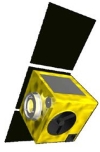 |
ChubuSat-3
Kinshachi
3
(MHI)
#41339
(2016-012C) |
ChubuSat-3
is a 50kg-class microsatellite built by Nagoya University.
In 2014, ChubuSat-3 was selected as one of the piggy-back
payload of H-IIA launch vehicle. The primary mission
of ChubuSat-3 is to observe the situation of the global
warming such as reduction of the glacier or retreat
of the shoreline. For this mission, ChubuSat-3 has a
high resolution camera. A secondary mission is to observe
space debris. It
features a UHF CW beacon at 437.425 MHz and a VHF/UHF
Store-and-Foreward payload. The uplink is at 145.840
MHz in 1k2 AFSK and the downlink is at 437.425 MHz in
9k6 GMSK. The callsign is JJ2YPO. |
Feb.
17th 2016 |
 Luciano
PY5LF received the CW beacon downlink signal of Chubusat-3
on February 18th 2016 on 437.416
MHz. Recording kindly provided by Luciano PY5LF. Luciano
PY5LF received the CW beacon downlink signal of Chubusat-3
on February 18th 2016 on 437.416
MHz. Recording kindly provided by Luciano PY5LF.
|
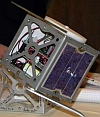
|
OUFTI-1
#41458
(2016-025C) |
AAUSAT-4, E-st@r-II
and OUFTI-1 are 1U CubeSats launched on Monday, April
25th at
21:02 UTC on a Russian Soyuz-STA Fregat-M rocket from
Kourou / French Guyana. They are secondary
payloads to the Earth Observation Satellite Sentinel-1B.
The three CubeSats were developed by student teams under
the European Space Agency (ESA) Education Office “Fly
Your Satellite!” program, which is aimed at training
the next generation of aerospace professionals. OUFTI-1
was built by the University of Liege in Belgium and
will be the first satellite to carry a DSTAR Digital
Voice Transponder. It transmits on 145.950 MHz FSK and
D-STAR with the corresponding D-STAR uplink at 435.045
MHz. Its CW beacon transmits on 145.980
MHz. |
Apr.
25th 2016 |
 Francisco
EA7ADI received the CW beacon signal of OUFTI-1 on April
27h 2016 at 18:10 UTC on 145.980
MHz. Recording kindly provided by Francisco EA7ADI. Francisco
EA7ADI received the CW beacon signal of OUFTI-1 on April
27h 2016 at 18:10 UTC on 145.980
MHz. Recording kindly provided by Francisco EA7ADI.
|
 On May
2nd 2016 at 16:35 UTC Peter
ON4EZJ received the CW beacon of OUFTI-1 on 145.9725
MHz. Recording kindly provided by Peter ON4EZJ. On May
2nd 2016 at 16:35 UTC Peter
ON4EZJ received the CW beacon of OUFTI-1 on 145.9725
MHz. Recording kindly provided by Peter ON4EZJ.
|
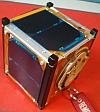
|
E-st@r-II
#41459
(2016-025D) |
AAUSAT-4, E-st@r-II
and OUFTI-1 are 1U CubeSats launched on Monday, April
25th at
21:02 UTC on a Russian Soyuz-STA Fregat-M rocket from
Kourou / French Guyana. They are secondary
payloads to the Earth Observation Satellite Sentinel-1B.
The three CubeSats were developed by student teams under
the European Space Agency (ESA) Education Office “Fly
Your Satellite!” program, which is aimed at training
the next generation of aerospace professionals. E-st@r-2
was built by the Polytechnic of Turin in Italy and will
demonstrate an attitude control system measurements
of the Earth's magnetic field. It will transmit on 437.825
MHz in CW and 1200bd AFSK.
The signal from
the e-st@r satellite 1200 bps beacon is very weak which
may indicate an antenna deployment issue or unexpectedly
low transmit power. |
Apr.
25th 2016 |
  Roland
PY4ZBZ recorded the CW beacon of E-st@r-2 on May 4th
2016 at 21:15h UTC on 437.485 MHz. Recording and audiogram
kindly provided by Roland Zurmely PY4ZBZ. Roland
PY4ZBZ recorded the CW beacon of E-st@r-2 on May 4th
2016 at 21:15h UTC on 437.485 MHz. Recording and audiogram
kindly provided by Roland Zurmely PY4ZBZ.
|

|
AAUSAT-4
OZ4CUB
#41460
(2016-025E) |
AAUSAT-4, E-st@r-II
and OUFTI-1 are 1U CubeSats launched on Monday, April
25th at
21:02 UTC on a Russian Soyuz-STA Fregat-M rocket from
Kourou / French Guyana. They are secondary
payloads to the Earth Observation Satellite Sentinel-1B.
The three CubeSats were developed by student teams under
the European Space Agency (ESA) Education Office “Fly
Your Satellite!” program, which is aimed at training
the next generation of aerospace professionals. AAUSAT-4
was built by the University of Aalborg in Denmark and
operates an automated ocean vessel identification system.
It transmits on 437.425 MHz using the
callsign OZ4CUB. |
Apr.
25th 2016 |
 Francisco
EA7ADI received the CW beacon of AAUSAT-4 on June 21st
2016 at 18:08 UTC on 437.425 MHz. Recording kindly provided
by Francisco EA7ADI. Francisco
EA7ADI received the CW beacon of AAUSAT-4 on June 21st
2016 at 18:08 UTC on 437.425 MHz. Recording kindly provided
by Francisco EA7ADI.
|
 Francisco
EA7ADI received the CW beacon of AAUSAT-4 on June 22nd
2016. Recording kindly provided by Francisco EA7ADI. Francisco
EA7ADI received the CW beacon of AAUSAT-4 on June 22nd
2016. Recording kindly provided by Francisco EA7ADI.
|
 Mineo
Wakita, JE9PEL, received the 2400bd GFSK downlink signal
on 437.425 MHz of AAUSAT-4 on August 28th
2017 at 10:47 UTC. Recording kindly provided by Wakita
san JE9PEL. Mineo
Wakita, JE9PEL, received the 2400bd GFSK downlink signal
on 437.425 MHz of AAUSAT-4 on August 28th
2017 at 10:47 UTC. Recording kindly provided by Wakita
san JE9PEL.
|
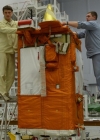
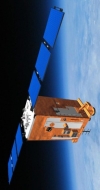
|
AIST 2D
Stork'2D
RS-48
#41465
(2016-026B) |
AIST-2D is a technology
demonstration and scientific research satellite developed
at Samara Aerospace University in cooperation with satellite
manufacturer TsSKB-Progress. It has a weight of 531
kg and was launched together with RS 48
(SamSat 218D). One of the 8 payloads on board is a P-band
radar BiRLK, that can transmit 200 W pulses in the 435
MHz band with a bandwidth of 1 - 30 MHz.
The
frequencies of Aist 2D / RS-48 are:
AIST-2D / RS-48
Downlinks
•
435.3065 – 435.3235 MHz Telemetry Data (435.315 MHz)
•
435.3565 – 435.3735 MHz Telemetry Data (435.365 MHz)
•
433 – 438 MHz 200 Watt Synthetic Aperture Radar (SAR)
•
8025 – 8393 MHz Remote Sensing Data
AIST-2D / RS-48
Uplinks
• 145.831 – 145.849 MHz Control
Link
• 145.861 – 145.879 MHz Control Link
AIST-2D transmits
telemetry on 435.315 MHz, identifying itself as 'RS
48'. |
Apr.
28th 2016 |
  Enrico
IW2AGJ recorded the bacon of AIST-2D on May 9th
2016 at 09:43h UTC during orbit #171 on 435.3561 MHz
in FM. Recording and spectrum kindly provided by Enrico
IW2AGJ. Enrico
IW2AGJ recorded the bacon of AIST-2D on May 9th
2016 at 09:43h UTC during orbit #171 on 435.3561 MHz
in FM. Recording and spectrum kindly provided by Enrico
IW2AGJ.
|
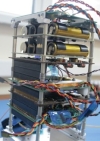
|
SAMSAT-218D
Kontakt-Nanosputnik
RS-48
#41466
(2016-026C) |
On
April 28th 2016 at 02:01 UTC,
the Russian 3U cubesat SamSat 218D (aka 'Kontakt-Nanosputnik')
was launched from the new Russian satellite launch base
'Vostochny' ('Eastern') in eastern Siberia. SamSat 218D
was built at the Samara State University.
The frequencies
of SAMSAT-218D are:
145.850
- 145.890 MHz (TRXSSAU
downlink)
435.590 - 435.610 MHz (TRXSSAU uplink)
I am searching
for sound files. Please send them to
 |
Apr. 28th
2016 |
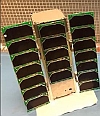
|
MinXSS-1
#41474
(1998-067HU) |
Together
with CADRE also MinXSS-1 (Miniature X-Ray Solar Spectrometer)
was deployed on May 16th 2016 at 10:05 UTC. This
3U CubeSat was built by scientists and engineers at
the University of Colorado, Boulder and the Laboratory
for Atmosheric and Space Physics (LASP). Over 40 graduate
students, 3 undergraduate students and one high school
student have worked on MinXSS. It will transmit 9600bd
FSK signals on 437.345 MHz. |
May
16th 2016 |
 Francisco
EA7ADI received the 9600bd FSK signal of MINXSS on July
10th 2016 at 10:10 UTC on 437.345
MHz in FM. Recording kindly provided by Francisco EA7ADI. Francisco
EA7ADI received the 9600bd FSK signal of MINXSS on July
10th 2016 at 10:10 UTC on 437.345
MHz in FM. Recording kindly provided by Francisco EA7ADI.
|
 On
May 16th 2016 Roland PY4ZBZ
received and decoded the downlink signal of MinXSS-1.
Spectrum and waterfall plot kindly provided by Roland
Zurmely PY4ZBZ. On
May 16th 2016 Roland PY4ZBZ
received and decoded the downlink signal of MinXSS-1.
Spectrum and waterfall plot kindly provided by Roland
Zurmely PY4ZBZ.
|
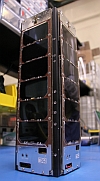
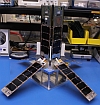
|
CADRE
NanoRacks-CADRE
#41475
(1998-067HV) |
Together
with MinXSS-1 also CADRE (Cubesat investigating Atmospheric
Density Response to Extreme driving) was deployed on
May 16th 2016 at 10:05 UTC. This
3U CubeSat was built by the University of Michigan.
It will transmit 9600bd FSK signals on 437.485 MHz and
feature also a downlink at 3404 MHz.
I am searching
for sound files. Please send them to
 |
May 16th
2016 |

|
STMSAT-1
#41476
(1998-067HW) |
A
Slow Scan TV (SSTV) CubeSat developed by students at
Saint Thomas More Cathedral School (STM) in Arlington,
VA, was deployed from the International Space Station
on May 16th 2016 at 14:40 UTC. STM
is thought to be the first Elementary school to build
their own satellite, even Pre-Kindergarten, Kindergarten,
and First Grade students were involved in the project.
The satellite, a 1U CubeSat
called STMSat-1, will transmit a SSTV Robot36 mode signal in FM modulation on
437.800 MHz.
I am searching
for sound files. Please send them to
 |
May 16th
2016 |

|
NODES-1
#41478
(1998-067HX) |
Together
with STMSAT-1 also two NODES cubesats (NODES-1 and NODES-2)
were deployed on May 16th 2016 at 14:40 UTC. These
1U CubeSats were built by students at Santa Clara University
and will demonstrate inter satellite communication.
They will transmit 1200bd AFSK signals on 437.100 MHz
and 115.2kbps spread spectrum FSK signals in the range
of 2401.2...2431.2 MHz. |
May
16th 2016 |
 Francisco
EA7ADI received the 1200Bd AFSK beacon of NODES-1 on
June 25th 2016 at 09:48 UTC
on 437.100 MHz. Recording kindly provided by Francisco
EA7ADI. Francisco
EA7ADI received the 1200Bd AFSK beacon of NODES-1 on
June 25th 2016 at 09:48 UTC
on 437.100 MHz. Recording kindly provided by Francisco
EA7ADI.
|
 On
May 16th 2016 Roland PY4ZBZ
received and decoded the downlink signal of NODES-1.
Spectrum and waterfall plot kindly provided by Roland
Zurmely PY4ZBZ. On
May 16th 2016 Roland PY4ZBZ
received and decoded the downlink signal of NODES-1.
Spectrum and waterfall plot kindly provided by Roland
Zurmely PY4ZBZ.
|

|
NODES-2
#41477
(1998-067HY) |
Together
with STMSAT-1 also two NODES cubesats (NODES-1 and NODES-2)
were deployed on May 16th 2016 at 14:40 UTC. These
1U CubeSats were built by students at Santa Clara University
and will demonstrate inter satellite communication.
They will transmit 1200bd AFSK signals on 437.100 MHz
and 115.2kbps spread spectrum FSK signals in the range
of 2401.2...2431.2 MHz. |
May
16th 2016 |
 Francisco
EA7ADI received the 1200Bd AFSK beacon of NODES-2 on
June 22nd 2016 at 17:20 UTC
on 437.100 MHz. Recording kindly provided by Francisco
EA7ADI. Francisco
EA7ADI received the 1200Bd AFSK beacon of NODES-2 on
June 22nd 2016 at 17:20 UTC
on 437.100 MHz. Recording kindly provided by Francisco
EA7ADI.
|
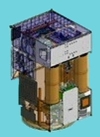
|
LUSEX-OSCAR
87
LO-87
NuSat-1
#41557
(2016-033B) |
The Argentinian
earth observation satellite ÑuSat-1 was launched
on a CZ-4B rocket from Taiyuan Satellite Launch Center
in China on May 30th 2016 at 03:17 UTC into a 500 km sun-synchronous
orbit with an inclination of 97.5 degrees and a Local
Time of the Ascending Node (LTAN) of 10:30. This first satellite
of a constellation of 25 has the dimensions of 40 cm
× 43 cm × 75 cm and a mass of 37 kg. The
spacecraft is equipped with an imaging system operating
in visible light and infrared. The constellation will
allow for commercially available real-time Earth imaging
and video with a ground resolution of 1 m. The satellite
was developed based on the experience gained on the
BugSat 1 (Tita) prototype satellite. An S/X transponder
with 2 W of output power for 8 GHz downlink and 2 GHz
uplink will be operating on 100 kHz bandwidth. For backup
telemetry, designers are considering an UHF transponder
operating at 9k6 GFSK.
ÑuSat-1, also
called LUSEX-OSCAR 87 (LO-87), carries a linear transponder
built by AMSAT Argentina. The
inverting U/V transponder, named LUSEX (LU satellite
experiment), has an uplink of 435.935 MHz to 435.965
MHz and a downlink of 145.935
MHz to 145.965 MHz. Total power output is 250 mW. There
is also a CW beacon at 145.900 MHz with a power output
of 70 mW. NuSat-1 also features a GFSK telemetry beacon
at 436.445 MHz. |
May
30th 2016 |
 Luciano
PY5LF received the transponder downlink signal of LO-87
on February 14th 2017 at 13:10
UTC on 145.953 MHz. Recording kindly provided by Luciano
PY5LF. Luciano
PY5LF received the transponder downlink signal of LO-87
on February 14th 2017 at 13:10
UTC on 145.953 MHz. Recording kindly provided by Luciano
PY5LF.
|
 Mineo
Wakita, JE9PEL, received the 40kbd GFSK telemetry downlink
signal on 436.445 MHz of NUSAT-1 on September 23rd
2017 at 19:22 UTC. Recording kindly provided by Wakita
san JE9PEL. Mineo
Wakita, JE9PEL, received the 40kbd GFSK telemetry downlink
signal on 436.445 MHz of NUSAT-1 on September 23rd
2017 at 19:22 UTC. Recording kindly provided by Wakita
san JE9PEL.
|

|
NuSat-2
#41558
(2016-033C) |
Together with NuSat-1
also NuSat-2 was launched. It features a GFSK telemetry
beacon operating at 437.445 MHz. |
May
30th 2016 |
  Jan
PE0SAT received the GFSK downlink signal of NuSat-2
on June 1st 2016 at 21:09 UTC
on 437.438 MHz. He provided an I/Q-File which I demodulated
in FM to hear the pulses and I generated also enclosed
spectrum display. Recording kindly provided by Jan van
Gils PE0SAT. Jan
PE0SAT received the GFSK downlink signal of NuSat-2
on June 1st 2016 at 21:09 UTC
on 437.438 MHz. He provided an I/Q-File which I demodulated
in FM to hear the pulses and I generated also enclosed
spectrum display. Recording kindly provided by Jan van
Gils PE0SAT.
|
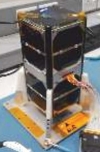 |
Sathyabamasat
SB-Sat
#41600
(2016-040B) |
Sathyabamasat
is a
2U cubesat with a weight of 1.5 kg. The spacecraft is
designed to measure the densities of the green house
gases over the region in which it moves on using ARGUS
1000 IR Spectrometer payload. The payload is operated
(switched ON) over the regions where we are interested,
and it delivers the data to the On-Board Computer (OBC)
for transmission, when it crosses the radio window of
ground station, which is being built in Sathyabama University
premises, Chennai, India.
It
features an UHF uplink and a VHF downlink . The downlink
is at 145.980 MHz, mode 2400 bps BPSK and CW, output
power 200mW
I am searching
for sound files. Please send them to
 |
June 22nd
2016 |
 |
LAPAN-A3
#41603
(2016-040E) |
Downlink 437.325 MHz
Mode: 1200 bps AFSK AX.25 APRS-Digipeater |
June
22nd 2016 |
 Francisco
EA7ADI received the 1200Bd FFSK beacon of LAPAN-A3 on
July 6th 2016 at 09:24 UTC
on 437.325 MHz in FM. Recording kindly provided by Francisco
EA7ADI. Francisco
EA7ADI received the 1200Bd FFSK beacon of LAPAN-A3 on
July 6th 2016 at 09:24 UTC
on 437.325 MHz in FM. Recording kindly provided by Francisco
EA7ADI.
|

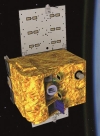
|
BIROS
#41604
(2016-040F) |
The
Firebird payload of the BIROS satellite determines the
position and selected fire parameters of already active
or newly emerging fires, like temperature, energy, and
surface area. The data is transmitted directly to mobile
devices. To make that possible the image data are processed
already on board and the results are sent over a special
modem as an “SMS”. Besides an optical laser downlink
it features also an UHF/S-Band downlink. The UHF downlink
operates at 437.525 MHz, mode 4800 bps
GMSK using the Mobitex protocol.
BIROS will deploy BEESAT-4 some weeks
after the launch of BIROS.
I am searching
for sound files. Please send them to
 |
June 22nd
2016 |
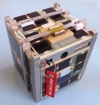 |
BeeSat-4
#41619
(2016-040W) |
BEESAT-4 is a 1U cubesat
built by Technische Universität Berlin. BEESAT-4
was deployed by BIROS on September 9th
2016. The CW beacon using the callsign DP0BEH was activated
at 12:41 UTC.
Downlink 435.950 MHz, Modes 4800
bps GMSK and CW |
June
22nd 2016 |
 Jan PE0SAT
received the CW beacon as well as the 4800bd GMSK downlink
signal of BeeSat-4 on September 9th
2016 at 18:42 UTC on 435.9577 MHz. Recording kindly
provided by Jan van Gils PE0SAT. Jan PE0SAT
received the CW beacon as well as the 4800bd GMSK downlink
signal of BeeSat-4 on September 9th
2016 at 18:42 UTC on 435.9577 MHz. Recording kindly
provided by Jan van Gils PE0SAT.
|
 Also on
September 12th 2016 at 10:12
UTC Jan PE0SAT received the 4800bd GMSK downlink signal
of BeeSat-4 on 435.9589 MHz. Recording kindly provided
by Jan van Gils PE0SAT. Also on
September 12th 2016 at 10:12
UTC Jan PE0SAT received the 4800bd GMSK downlink signal
of BeeSat-4 on 435.9589 MHz. Recording kindly provided
by Jan van Gils PE0SAT.
|
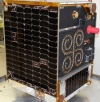 |
M3MSAT
#41605
(2016-040G) |
The
Maritime Monitoring and Messaging Microsatellite (M3MSat)
developed by COM DEV Ltd. and SFL was successfully launched
on Polar Satellite Launch Vehicle PSLV-C34 from Sriharikota,
India.
This 95 kg satellite features
2 downlinks. The LDRS (Low Data Rate Service) Downlink
operates at 400.575 MHz. The 6.25Mbit/s BPSK, QPSK,
OQPSK Downlink operates at 2237.5 MHz with an output
power of 2.2W
I am searching
for sound files. Please send them to
 |
June 22nd
2016 |

|
Swayam
COEP
Swayam-1
#41607
(2016-040J) |
Swayam-1 was developed
by students at the College of Engineering Pune (COEP).
it will provide a text messaging facility using the
COEPSAT protocol. Its downlink is at 437.025 MHz. The
beacon frequency is 437.025 MHz. The mode is 1200 bps
BPSK and CW. |
June
22nd 2016 |
 Jean-Pierre
F5YG received the CW beacon of SWAYAM on June 23rd
2016 at 09:50 UTC during orbit #20 on 437.025 MHz. The
strings being spaced from each other by about 90 seconds
were: Jean-Pierre
F5YG received the CW beacon of SWAYAM on June 23rd
2016 at 09:50 UTC during orbit #20 on 437.025 MHz. The
strings being spaced from each other by about 90 seconds
were:
SWAYAMSNBNNN
SWAYAMSNVNNN
SWAYAMSNMNNN
SWAYAMSNUNNN
SWAYAMSNSNNN
Pauses were removed
in the recording which was kindly provided by Jean-Pierre
F5YG
|
 Francisco
EA7ADI received the CW beacon of SWAYAM on June 23rd
2016 at 09:57 UTC on 437.025 MHz. Recording kindly provided
by Francisco EA7ADI. Francisco
EA7ADI received the CW beacon of SWAYAM on June 23rd
2016 at 09:57 UTC on 437.025 MHz. Recording kindly provided
by Francisco EA7ADI.
|
 Also on
June 25th 2016 at 09:23 UTC
Francisco EA7ADI received the CW beacon of SWAYAM on
437.025 MHz. Recording kindly provided by Francisco
EA7ADI. Also on
June 25th 2016 at 09:23 UTC
Francisco EA7ADI received the CW beacon of SWAYAM on
437.025 MHz. Recording kindly provided by Francisco
EA7ADI.
|
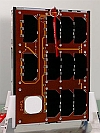
|
3CAT-2
#41732
(2016-051B) |
This 6U Cubesat named
Cube-Cat-Two built by Universitat Politecnica des Catalunya
in Barcelona/Spain. The weight is 7kg. It was launched
together with QSS on August 15th
2016 from Jiquan, PRC, on a Long March 2D rocket into
a 485km x 503km orbit with an inclination of 97.4 degree.
Downlinks 145.970 MHz 9600Bd BPSK
and 2401.00 MHz 100kbps GMSK |
Aug.
15th 2016 |
 Jan PE0SAT
received the 9600bd BPSK downlink signal of 3CAT-2 on
August 24th 2016 at 23:55 UTC
on 145.970 MHz. Recording kindly provided by Jan van
Gils PE0SAT. Jan PE0SAT
received the 9600bd BPSK downlink signal of 3CAT-2 on
August 24th 2016 at 23:55 UTC
on 145.970 MHz. Recording kindly provided by Jan van
Gils PE0SAT.
|
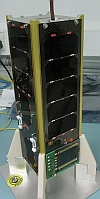
|
AlSat-1N
#41789
(2016-059G) |
AlSat-1N
is a 3U cubesat built in collaboration between the Algerian
Space Agency (ASAL), UK Space Agency (UKSA), Surrey
Space Centre (SSC) and Algerian students. It was launched
on the Indian PSLV-C35 mission . It features a 9600bpsk
FSK downlink on 437.650 MHz. |
Sept.
26th 2016 |
 Jan PE0SAT
received the 9600bd BPSK downlink signal of AlSat-1N
on September 23rd 2016 at 12:08
UTC on 437.519 MHz. Recording kindly provided by Jan
van Gils PE0SAT. Jan PE0SAT
received the 9600bd BPSK downlink signal of AlSat-1N
on September 23rd 2016 at 12:08
UTC on 437.519 MHz. Recording kindly provided by Jan
van Gils PE0SAT.
|
 Also
IW2AGJ received the BPSK downlink of AlSat-1N on 437.645
MHz on December 27th 2016 at
10:06 UTC. Spectrum plot kindly provided by Enrico IW2AGJ. Also
IW2AGJ received the BPSK downlink of AlSat-1N on 437.645
MHz on December 27th 2016 at
10:06 UTC. Spectrum plot kindly provided by Enrico IW2AGJ.
|
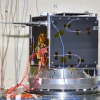

|
Pratham
#41791
(2016-059J) |
The
satellite Pratham, built by students at the Indian Institute
of Technology Bombay, is expected to launch on the Indian
PSLV-C35 mission currently planned for September 26th
2016. Pratham, a 300x300x300mm satellite with a mass
of 10 kg, aims to measure total electron count in a
800 km altitude Sun Synchronous Orbit (SSO). Here are
the planned downlinks:
Beacon:
Frequency: 145.980 MHz, Mode: CW, wpm: 35 words,
(The CW beacon will be on through out the orbit and
can be received from anywhere.)
Downlink:
Frequency: 437.455 MHz, Mode: FSK, Baudrate: 1200 bps
(To be switched on over France and India only) |
Sept.
26th 2016 |
 Jean-Pierre
F5YG received the CW beacon during Pratham's orbit #43
on September 29th 2016 on 145.980
MHz. Recording kindly provided by F5YG. Jean-Pierre
F5YG received the CW beacon during Pratham's orbit #43
on September 29th 2016 on 145.980
MHz. Recording kindly provided by F5YG.
|
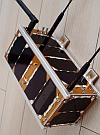
 |
CAS-2T
Fengtai-1
Dream 1
#41847
(2016-066G) |
CAS-2T
(Dream 1) is a technical verification satellite for
CAMSAT CAS-2 series amateur radio satellites. Developed
by middle school students with the support of China's
Academy of Launch Vehicle Technology, the Science and
Technology Museum, and the Eastern Highlands Qian Youth
Space Sciences Organization, the 2U CubeSat carries
a ham radio 145/435 MHz FM transponder. CAS-2T was
intentionally not separated from the final stage of
rocket CZ-11(Y2).
The
final stage was originally expected to be in orbit for
up to 30 days before re-entering the Earth’s atmosphere
but reports indicate the orbit is 504 x 1030 km which
could give an orbital lifetime of several years.
Amateur radio payload frequencies are:
CW Telemetry Beacon:435.710MHz
FM Transponder Uplink:145.925MHz
FM Transponder Downlink:435.615MHz |
Nov
9th 2016 |
 Luciano
PY5LF received the CW beacon downlink signal of CAS-2T
on November 23rd 2016 at 21:00
UTC on 435.710 MHz. Recording kindly provided by Luciano
PY5LF. Luciano
PY5LF received the CW beacon downlink signal of CAS-2T
on November 23rd 2016 at 21:00
UTC on 435.710 MHz. Recording kindly provided by Luciano
PY5LF.
|
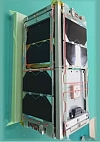
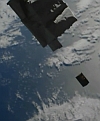
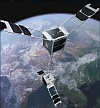
|
STARS-C
#41895
(1998-067KR) |
STARS-C (Space Tethered
Autonomous Robotic Satellite) , built by Shizuoka University
in Japan, was deployed from ISS using JSSOD (Kibo module)
on Dec. 19th 2016 at 08:30
UTC. After it was released by ISS the satellite did
split in two satellites, mother and daughter which are
connected by a 100 meter long tether. STARS-C is based
on a 2U cubesat structure with a weight of 2.7kg. The
mission of this satellite is to explore space elevator
technology. The data of the experiment will be sent
to Earth using Amateur Radio frequencies and Radio Amateurs
around the world will help to collect the scientific
data. |
Dec
19th 2016 |
 Francisco
EA7ADI received the CW beacon signal of STARS-C mother
on January 6th 2017 at 10:45
UTC. Recording kindly provided by Francisco EA7ADI. Francisco
EA7ADI received the CW beacon signal of STARS-C mother
on January 6th 2017 at 10:45
UTC. Recording kindly provided by Francisco EA7ADI.
|
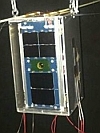
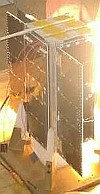
|
BY70-1
#41909
(2016-083C) |
BY70-1 (Bayi kepu weixing
01 xing) is a Chinese satellite which was developed
by high school students at the PLA-related Bejing Bayi
School. It was launched on December 28th
2016 at 03:23 UTC from Taiyuan launch center on a Long
March 2D launch vehicle. Unfortunately the launch was
not successful and thus BY70-1 did not reach the target
circular orbit with an altitude of 520 km. Instead the
satellite is an elliptical orbit with an apogee of 524km
and a perigee of 213km. Thus the lifetime of the satellite
will be very limited.
BY70-1 carries an FM transponder
with the uplink frequency of 145.929 MHz and the downlink
frequency of 436.200 MHz. A CTCSS tone with 67 Hz has
to be used. There seems to be a delay of the downlink
versus uplink of up to 0.5 seconds.
In addition BY70-1 also feature a
9k6 telemetry downlink on 436.200 MHz sending packet
bursts every 30 seconds.
BY70-1 decayed on February 18th
2017. |
Dec
28th 2016 |
  The FM
transponder of BY70-1 was revceived and recorded on
December 31st 2016 at 09:32
UTC by IW2AGJ. You can hear a nice QSO between F4DXV
and 9A2EY on the downlink frequency of 436.209 MHz.
Recording and spectrum plot kindly provided by Enrico
IW2AGJ. The FM
transponder of BY70-1 was revceived and recorded on
December 31st 2016 at 09:32
UTC by IW2AGJ. You can hear a nice QSO between F4DXV
and 9A2EY on the downlink frequency of 436.209 MHz.
Recording and spectrum plot kindly provided by Enrico
IW2AGJ.
|
 Enclosed
recording of the 9k6 telemetry downlink on 436.200 MHz
was made on December 28th 2016
at 11:20 UTC and kindly provided by Tetsu-san JA0CAW. Enclosed
recording of the 9k6 telemetry downlink on 436.200 MHz
was made on December 28th 2016
at 11:20 UTC and kindly provided by Tetsu-san JA0CAW.
|
 Francisco
EA7ADI received the FM transponder downlink of BV70-1
on January 2nd 2017 at 10:58
UTC. You can hear the special call II0IAAR calling CQ.
Recording kindly provided by Francisco EA7ADI. Francisco
EA7ADI received the FM transponder downlink of BV70-1
on January 2nd 2017 at 10:58
UTC. You can hear the special call II0IAAR calling CQ.
Recording kindly provided by Francisco EA7ADI.
|
Picture |
Satellite
#NORAD |
Description |
Launch Date |